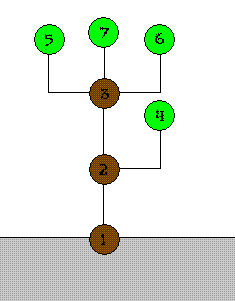| Time Limit: 3000MS | Memory Limit: 131072K | |
| Total Submissions: 22903 | Accepted: 4962 |
Description
 Christmas is coming to KCM city. Suby the loyal civilian in KCM city is preparing a big neat Christmas tree. The simple structure of the tree is shown in right picture.
Christmas is coming to KCM city. Suby the loyal civilian in KCM city is preparing a big neat Christmas tree. The simple structure of the tree is shown in right picture.
The tree can be represented as a collection of numbered nodes and some edges. The nodes are numbered 1 through n. The root is always numbered 1. Every node in the tree has its weight. The weights can be different from each other. Also the shape of every available edge between two nodes is different, so the unit price of each edge is different. Because of a technical difficulty, price of an edge will be (sum of weights of all descendant nodes) × (unit price of the edge).
Suby wants to minimize the cost of whole tree among all possible choices. Also he wants to use all nodes because he wants a large tree. So he decided to ask you for helping solve this task by find the minimum cost.
Input
The input consists of T test cases. The number of test cases T is given in the first line of the input file. Each test case consists of several lines. Two numbers v, e (0 ≤ v, e ≤ 50000) are given in the first line of each test case. On the next line, v positive integers wi indicating the weights of v nodes are given in one line. On the following e lines, each line contain three positive integers a, b, c indicating the edge which is able to connect two nodes a and b, and unit price c.
All numbers in input are less than 216.
Output
For each test case, output an integer indicating the minimum possible cost for the tree in one line. If there is no way to build a Christmas tree, print “No Answer” in one line.
Sample Input
2 2 1 1 1 1 2 15 7 7 200 10 20 30 40 50 60 1 2 1 2 3 3 2 4 2 3 5 4 3 7 2 3 6 3 1 5 9
Sample Output
15 1210
这题以前用Dijkstra+stl做过,今天学习下手写heap,重做了一遍
#include<stdio.h> #include<string.h> #include<iostream> using namespace std; const int MAXN = 50000+100; const long long INF = 10000000000; typedef pair<long long,int>plli; struct Edge { int to,next; long long w; }edge[MAXN*2]; int head[MAXN],tol; long long dis[MAXN]; long long val[MAXN]; bool vis[MAXN]; plli heap[MAXN*2]; int num; int n,m; void init() { tol=0; num=0; memset(head,-1,sizeof(head)); } void addedge(int u,int v,long long w) { edge[tol].to=v; edge[tol].w=w; edge[tol].next=head[u]; head[u]=tol++; } int cmp(plli x,plli y) { return x.first<y.first; } plli top() { return heap[1]; } void push(plli x) { int par,son; plli temp=x; heap[++num]=x; for(son=num,par=son/2;son>1;son=par,par=son/2) { if(cmp(temp,heap[par])) //儿子更小,向上移动 heap[son] = heap[par]; //父亲滑下来覆盖儿子 else break; //终于儿子已经比父亲大了,那么不用再比较了 } heap[son]=temp; } void pop() { int son,par; plli temp; heap[1]=heap[num--]; temp=heap[1]; for(par=1,son=par*2;son<=num;par=son,son=par*2) { if(son<num&&cmp(heap[son+1],heap[son])) son++; if(cmp(temp,heap[son])) break; heap[par]=heap[son]; } heap[par]=temp; } long long Dijkstra() { int cnt=0; long long res=0; for(int i=1;i<=n;i++) dis[i]=INF,vis[i]=false; dis[1]=0; push(make_pair(dis[1],1)); while(num>0) { int u,v; long long w; plli x=top(); pop(); u=x.second; if(vis[u]) continue; vis[u]=true; cnt++; res+=dis[u]*val[u]; for(int i=head[u];i!=-1;i=edge[i].next) { v=edge[i].to; w=edge[i].w; if(dis[u]+w<dis[v]) { dis[v]=dis[u]+w; push(make_pair(dis[v],v)); } } } if(cnt<n) return -1; return res; } int main() { int T; int u,v; long long w; scanf("%d",&T); while(T--) { init(); scanf("%d%d",&n,&m); for(int i=1; i<=n; i++) scanf("%lld",&val[i]); if(n==0||n==1) { printf("0 "); continue; } for(int i=1;i<=m;i++) { scanf("%d%d%lld",&u,&v,&w); addedge(u,v,w); addedge(v,u,w); } long long res=Dijkstra(); if(res!=-1) printf("%lld ",res); else printf("No Answer "); } return 0; }